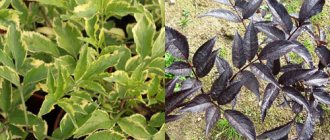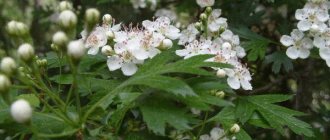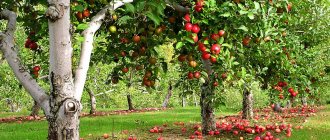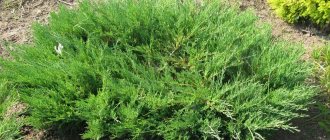The dream of every gardener is to uniquely personalize their garden plot, to make it unusual and inimitable. So that the heart rejoices from contemplation, oh neighbors and passers-by are white-eyed. Of course, there are many ways to bring your plans to life. Using unusual plants for your garden is the most effective and efficient way.
Yes, it won't be easy. Yes, this is a challenge for the gardener. Yes, most exotics do not take root in our climate in open ground, and therefore the only way to grow them is to place them in a large tub and carefully care for them. But this is the only opportunity to surprise yourself and others, and turn the garden not only into the pride of your dacha, but also into the highlight of the entire dacha village.
Snow tree (Chionanthus)
Chionanthus, snowflower or simply snow tree is an exotic that opens our list of Top 9 unusual trees for the garden. In the plant’s homeland, North America, it is called “grandfather’s beard.” Apparently because the white flowers look like gray hairs.
Blooming Chionanthus is a truly unforgettable sight. Its unusual inflorescences look more like fringe or homemade thin pompoms consisting of many paper strips. A light breeze is enough to set the Virginia snowflower in motion. There is a feeling that the tree does not have a state of rest: it constantly sways, worries, rustles.
The snow tree blooms easily in temperate climates. and all because inflorescences arise on Chionanthus exclusively on young shoots of the current year.
Cercis
You've probably seen a photo on the Internet where there is a small patio in front of the house, on the territory of which a small tree of a completely architectural form grows. Moreover, this tree has red leaves. What a curiosity! If you begin to remember something, it means that you are familiar with the Canadian cercis, if not personally, then at least from a photograph.
This tree is rarely hidden in backyards. Most often it is planted in front of the house to decorate its façade. One cercis, which is popularly called the scarlet plant, is enough to transform a boring brick building. A distinctive feature of the purple plant is its young bright red leaves, which turn green during ripening and later turn into deep red. The leaves of the scarlet plant are heart-shaped, which certainly adds exotic appeal.
The crimson flower blooms very unusually. If at the moment the leaves appear on the tree it resembles some kind of cupid bush dotted with hearts, then during the flowering period the cercis turns into a pink-purple cloud thanks to the inflorescences, which are tightly pulled into bunches.
Cercis prefers alkaline, well-drained soil and may refuse to bloom if the winter was too harsh and the tree overwintered without proper shelter. However, if wintering is organized correctly, then from year to year the scarlet will increase its winter hardiness.
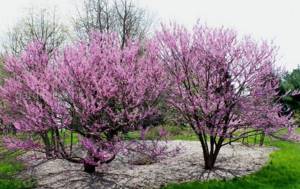
Garden cacti
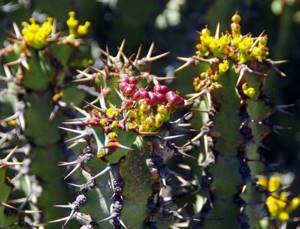
There are many types of cacti that can grow in the southern regions of Russia in open ground. Perhaps the most popular of them is prickly pear. During flowering, cactus petals emit a scent similar to watermelon, they are very impressive due to their smoothness and beautiful luminous hue. Prickly pear is used for landscaping local areas and succulent gardens.
Myrtillocactus usually has a columnar shape. It blooms in early summer with yellowish or bright white flowers. Plants are placed on the slopes of small hills or along garden paths.
Echinocereus is also called the king cactus. In spring, it bears red or pink flowers. The original feature of Echinocereus is thin spines entwining the stem and fruits. The plant is grown in pots; in summer it can be placed in the garden.
Japanese styrax (Styrax japonicus)
From the name it is clear that this exotic came to us from the Land of the Rising Sun. In truth, it must be said that Japanese styrax is still quite rare in domestic gardens. From time to time it can be seen in garden centers that specialize in exotic trees, but only a few undertake to grow Japanese styrax on their own. However, the fact remains: anyone who once saw how divinely this tree blooms will never be able to part with this incredible picture and will do everything to observe it as often as possible. Even if this requires making every effort - and growing exotic plants in your own garden.
Styrax blooms with large large bells. The flowers are quite loose. Hanging stamens are located inside the corolla. There are a lot of flowers - they practically stick around the tree. It is best to plant styrax where there is a lot of sun. Or at least in openwork partial shade. The soil should be fertile, but devoid of lime. Otherwise, styrax will neither develop nor bloom profusely.
Japanese Styrax needs winter shelter in the first years of its life. At a minimum, it must be covered with dry leaves. But it’s better to build a more thorough winter quarters, just to be sure.
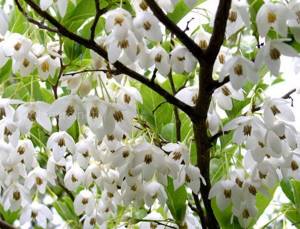
LiveInternetLiveInternet
Quote from lipa_fv
Read in full In your quotation book or community!
5 EXOTIC FLOWERS FOR YOUR GARDEN
I know that all amateur gardeners try very hard to decorate their garden with beautiful flowers and shrubs, and many love it when beautiful, “not like everyone else” flowers bloom in their flowerbeds. Here is a small selection of those that interested me... I. TRICYRTIS Tricyrtis or garden orchid (as well as toad lily) is the name of this beautiful flower. It has a very unusual and interesting story.
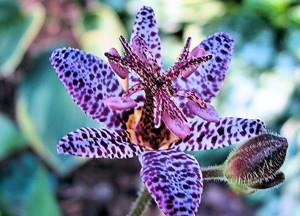
The flower was named toad lily by the Filipinos, who used the plant's juice in hunting frogs. In Japan, due to the dark spots on the petals, Tricyrtis is compared to a cuckoo, and in sophisticated Europe they found similarities with an orchid. Coming from the East, it appeared in our gardens in the mid-20th century, and very quickly won the love and admiration of fans.
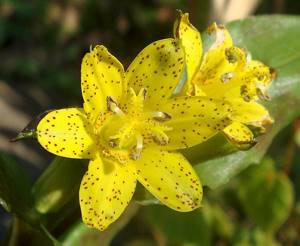
They are famous for the greatest resistance to cold: Tricyrtis short-haired, it came to us from Japan. The height of the plant reaches one meter. Blooms in August with white flowers with purple spots; Tricyrtis latifolia. It was imported from China. It blooms in July, the height of the bush is up to 60 cm.
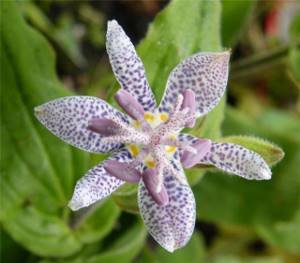
A garden orchid will be comfortable in the tree trunks - here the flower will be grown in partial shade, and the soil is usually well fertilized with rotted plant debris. Lilies, ferns, and erythroniums will be good neighbors for Tricyrtis. II.IXIA Ixia - the name comes from the Greek word “ixios”, which means “bird glue”, this is explained by the stickiness of Ixia juice. This is a garden plant that originates from South Africa and has been known to gardeners since 1770.
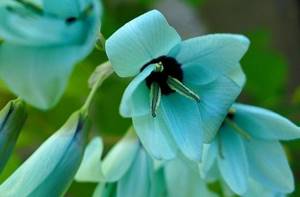
Ixia is a beautiful flowering plant with a corm-like root. 25 species are known. Ixia hybrida is used in gardens - it is a perennial plant that reaches half a meter in height; their colors can be very different - white, yellow, pink and red.
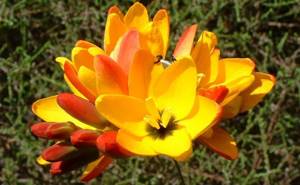
At night and in cloudy weather, the flowers close. Ixia will decorate your garden with its color luxury.
III.HILL GRUSE The hazel grouse is very popular among gardeners. This flower is unusual and beautiful, especially the imperial hazel grouse. In addition, it blooms in the spring, when there are still few flowering plants in the garden.
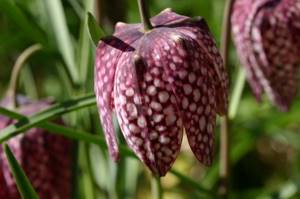
Mainly two ornamental species are bred in gardens: checkerboard hazel grouse and imperial hazel grouse. These plants differ in appearance from each other. Checkerboard hazel grouse is a low plant (up to 30 cm) with 1-2 flowers. Because of the ripples arranged in a checkerboard pattern, the flower received its name.

Imperial hazel grouse is a tall plant, sometimes the stems reach almost a meter in height. Its beautiful flowers of bright yellowish-red color are arranged in the form of a crown under the apical leaves. Hazel grouse usually bloom in April-May. It is good to combine planting hazel grouse with tulips. During drought, hazel grouse need to be watered, but should not be overwatered. When the flowers fade, they need to be carefully cut off and the leaves should not be touched.
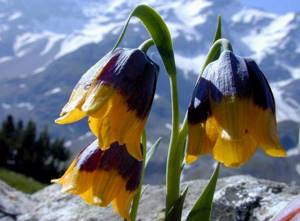
Hazel grouse should be planted in August-September to a depth of about 30 cm and at the same distance.
IV.GARDEN HIBISCUS Many flower gardeners know Hibiscus as a houseplant, but garden hibiscus is also sold under the name “Syrian Hibiscus”. By the way, white garden hibiscus grows in my dacha...
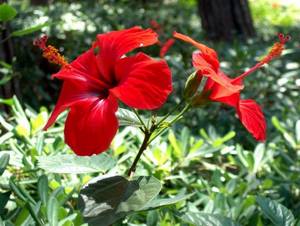
In nature, there are about 200 species of different hibiscus, if, where it is planted in fairly warm winters, there is an almost 100% guarantee that the flower will take root and will delight you with its unusually beautiful blooms every summer.
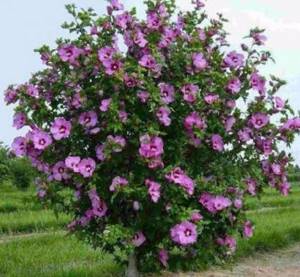
Garden hibiscus requires a lot of care. The main condition for planting it in the soil is good lighting. The flower does not like shade; only with a sufficient amount of ultraviolet light will the flower delight you with lush blooms in the garden. Syrian hibiscus goes well with any variety of roses. It grows no more than 1.5 meters in height and has a fairly compact shape. Hibiscus is considered an ideal plant for a rose garden or rock garden.
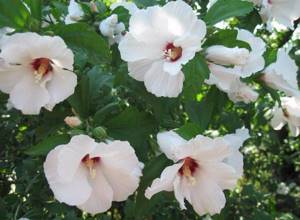
Hibiscus also looks very good as a single plant when decorating the landscape of a site. Plant lavender bushes around it, it is very beautiful, and the aroma of lavender will protect the Syrian hibiscus from aphids and insects. There are 2 types of this plant: double and non-terry varieties; terry varieties tolerate winter better and are more frost-resistant.
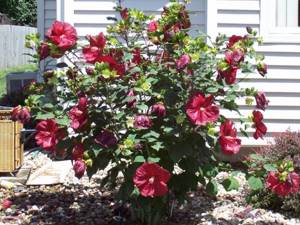
Syrian hibiscus does not require special soil. It takes root well where you plant roses. Typically, Syrian hibiscus is topped up once every two weeks. In the southern regions, where the conditions are most suitable for hibiscus and it is found everywhere, you can see various flowering compositions in the shape of a cube, ball, or pyramid.

A distinctive feature of hibiscus is that the lifespan of its flowers is very short, but despite this, a new one quickly opens in place of the previous one. Hibiscus is a perennial plant and can survive without replanting for up to 20 years.
V.ANEMONES Anemone or anemone is a genus of perennial herbaceous plants of the Ranunculaceae family. Flowers are pure white, yellow, lilac, green, blue, purple, pinkish or red
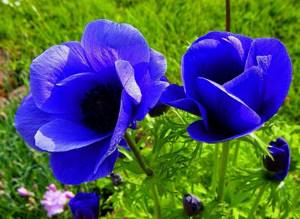
The name of the plant comes from the Greek word “anemos” - wind. Indeed, the petals of the hybrid anemone sway at the slightest breeze.
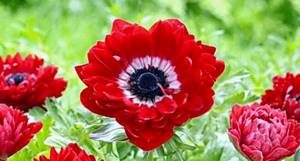
According to Greek legend, Anemone was the name of the nymph with whom Zephyr, the sweet spring wind, and Boreas, the god of the western winds, fell in love. Having learned about this, the goddess of flowers Flora became angry with the nymph and turned her into a flower.
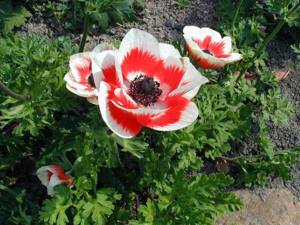
Lily of the valley tree (Halesia)
Galesia carolina is a stunning tree that produces bluebell flowers. Or lilies of the valley? Or is it still bells? The plant was brought to our country from North America - this is where the lily of the valley tree is born. But as practice shows, this exotic plant takes root well in a temperate climate. Especially if the gardener is ready to please him in every possible way.
Interestingly, of all the exotics, the lily of the valley tree winters best in the middle zone. This is partly due to the place of birth. Partly - subject to certain requirements. For example, it is very important that Galesia is planted in a location that is protected from drafts. It would be nice to surround it with bushes, which can serve as additional protection from the wind. The lily of the valley tree blooms at the end of May, and the foliage appears on it simultaneously with a scattering of flowers. There is a feeling that the tree is turning from an ugly duckling into a white swan before our eyes.
For abundant and long-lasting flowering, it is very important that it sits in fertile soil, devoid of lime.
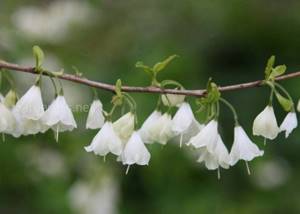
Catalpa
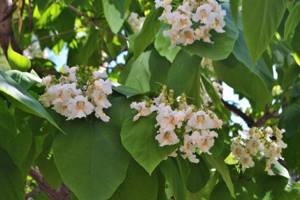
The deciduous six-meter tree feels quite confident in gardens of temperate latitudes. The catalpa has a very impressive spherical crown. Large and wide leaves, reminiscent of lilacs, do not turn yellow at the end of the season. The tree blooms in early summer with wonderful inflorescences with the aroma of apples. The fruits are funny capsules with flying seeds. Catalpa is planted in places protected from gusts of wind. Depending on the variety, the crop can be moisture-loving or drought-resistant. The soil substrate is desirable to be loose and light, with a neutral or slightly acidic reaction.
Chocolate creeper (Akebia)
Akebia quintuple is the official name of the chocolate vine, which domestic gardeners are just beginning to discover. You can’t argue: this is where the real exotics are, which until recently lived exclusively in Southeast Asia. The length of the chocolate vine can reach ten meters. Just imagine how unusual and bright this oriental beauty will look in your home garden! By the way, about brightness. Do you know why the vine was called chocolate? It's simple: its inflorescences are purple-chocolate in color, and when they fade, edible fruits appear in their place, which is especially unexpected for a vine.
The leaf of Akebia is five-fingered, dense and rather hard. This unusual plant for the garden will need to be covered for the winter. The gardener has to remove the vine from the support that holds it, coil it like a snake, and sprinkle it with a fair amount of dry leaves. But don’t worry so much: despite its southern origin, developing in the Ukrainian temperate climate, Akebia quintuple becomes stronger and more resistant to temperature changes and frosts from year to year.
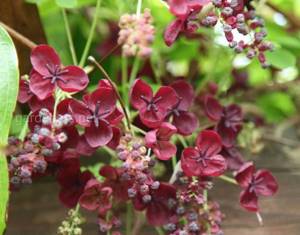
Tulip tree (Liriodendron)
Lyran or lyriodendron - this difficult name hides a stunning exotic giant that can grow in one place for not one, not two, or even three centuries in a row - but much longer. Its leaves are colored light green. They are a bit reminiscent of maple trees, but unlike maple foliage, tulip tree leaves have four corners. Liran blooms unusually: the inflorescences of this tree have an extraordinary red-green color. But not only the color, but also the shape of these flowers is amazing! The inflorescences are something between a tulip and a cyclamen. And the diameter of the flowers of the tulip tree sometimes reaches 10 centimeters.
In order for lyriodendron to grow well and develop efficiently, it must be planted on fertile soil. It is important that the location chosen for it in no way impedes the penetration of sunlight.
A young tree must be covered for the winter. But the older the Lyran gets, the more familiar the Ukrainian winter will be for him.
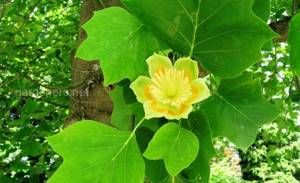
Ginkgo
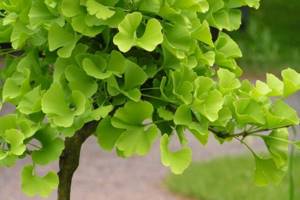
This relic of Japanese-Chinese origin can be grown at a dacha in central Russia. The seedling should be placed in the brightest area, but at first protected from direct rays. The tree is covered for the winter. The composition of the soil is not important, the main thing is that the soil is sufficiently moist. Ginkgo is planted in alleys next to conifers. In autumn, its foliage turns bright colors and takes on a fantastic appearance.
Horse chestnut pavia (Aesculus pavia)
You are all familiar with horse chestnut. So why not get acquainted with one of its most beautiful varieties - the pavia horse chestnut! This tree grows in the same regions where the traditional chestnut grows. And therefore, it develops without any difficulties in our temperate climate. It grows no more than three meters in height, but purely visually, pavia looks more like a bush than a tree in the traditional sense of the word.
The foliage of horse chestnut pavia is initially red. It turns green only at the beginning of summer. Flowers are also worthy of the close attention of gardeners and landscape designers: in pavia they are collected in red and yellow pyramidal bouquets and look incredibly elegant.
In winter, young pavia only needs light insulation. Over time, when the tree acclimatizes and gets stronger, the need for this will disappear altogether.
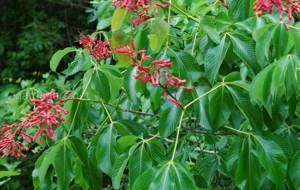
Euonymus
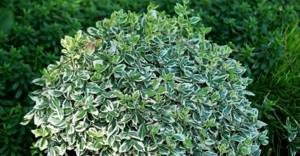
Euonymus has a very original textured stem with growths and clear edges. Specimens growing wild reach 4 m in height. The color of the leaves varies among different varieties - they can be spotted or plain.
Euonymus flowers are small and not particularly decorative; they are usually cream, burgundy or greenish in color. The fruits have a bright color and greatly decorate the plants.
Recent Entries
5 working ways to use tar in the garden 7 indoor plants that help you get married even in adulthood Indoor plants that can bloom in trouble
Advantages of growing euonymus:
- bushes look spectacular in group and single plantings;
- easy care, adaptability to the conditions of the middle zone;
- Compact types of euonymus can be used to delimit a garden plot into zones.
For seedlings of this crop, choose a sunny area with neutral or slightly alkaline soil. The soil must be drained and well fertilized beforehand.
Paulownia
Paulownia tomentosa is popularly called differently. Some people call this unusual plant for the garden the Adam's tree. Others are familiar with it as the Dragon Tree. This is a semi-evergreen giant that is especially attractive during the flowering period. Paulownia inflorescences resemble bells in shape. They are collected in armfuls in the form of tassels on the edges of the branches and look about the same as the abundance of ruffles on the sleeves of a medieval lady.
Paulownia blooms with “bells”, painted in different shades of purple: lilac, blue, lilac. Due to this, during the flowering period, the Adam's tree turns into a purple cloud, which you can admire endlessly.
The dragon tree must be covered for the winter. When choosing a location for a seedling, you need to give preference to a sunny place protected from the winds. Feeding is an essential part of the annual care of paulownia. Sometimes the tree freezes right down to the snow level.
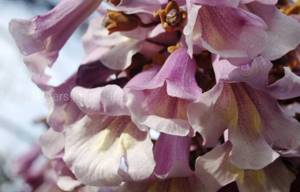
Locust
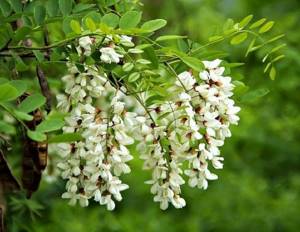
This tree in nature grows up to 25 meters. Sometimes it forms a lush bush. The bark is covered with cracks, and this texture is very beautiful. The plant has powerful roots that resist gusts of wind and strengthen the soil. In June, Robinia is covered with fragrant panicle inflorescences. The intricately folded petals resemble a pea flower. Robinia grows in any soil, but prefers loam. The place should be lit and protected from cold winds. Adult specimens do not need watering provided there is regular rainfall. Feed the tree with rotted manure.
Rooting Campsis (Campsis radicans)
The Campsis plant is one of the most beautiful large-flowered vines you will ever see. The second name of an unusual plant for the garden is trombone. You may also have seen or heard of this vine in a third interpretation: it is also called tekoma. However, the plant does not change from changing the name, as well as from changing the places of the terms. It remains just as attractive and stunning, with feathery leaves that reach ¼ meter in length and a huge number of tube flowers.
The length of the flowers is 9-10 centimeters. However, the flowers are not single. The inflorescences are collected in bouquets directly on the vine. And each such bouquet consists of ten to fifteen inflorescences, due to which it looks unusual and extremely attractive.
Trombone winters well in the temperate Ukrainian climate. If you didn’t have time or weren’t able to organize a shelter for the vine, then, in principle, you don’t have to worry too much. In our area, the temperature rarely drops below 20 degrees below zero. But such a temperature regime is not detrimental to Kampsis. But if the winter in your region is harsh, and the thermometer sometimes drops to 35 degrees below zero, be sure to cover the campsis when closing the summer season. By the way, Kampsis grows and develops very quickly. Therefore, if there was any damage on the vine that appeared after winter, the unusual plant for the garden will soon restore its former festive appearance.
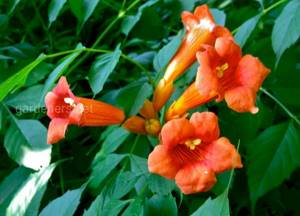
Join our Facebook group
